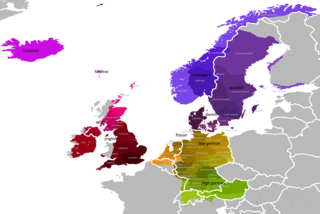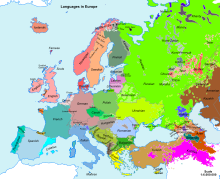In linguistics, a copula is a word or phrase that links the subject of a sentence to a subject complement, such as the word is in the sentence "The sky is blue" or the phrase was not being in the sentence "It was not being co-operative." The word copula derives from the Latin noun for a "link" or "tie" that connects two different things.

The Germanic languages are a branch of the Indo-European language family spoken natively by a population of about 515 million people mainly in Europe, North America, Oceania and Southern Africa. The most widely spoken Germanic language, English, is also the world's most widely spoken language with an estimated 2 billion speakers. All Germanic languages are derived from Proto-Germanic, spoken in Iron Age Scandinavia and Germany.

Interlingua is an international auxiliary language (IAL) developed between 1937 and 1951 by the American International Auxiliary Language Association (IALA). It is a constructed language of the "naturalistic" variety, whose vocabulary, grammar, and other characteristics are derived from natural languages. Interlingua literature maintains that (written) Interlingua is comprehensible to the hundreds of millions of people who speak Romance languages, though it is actively spoken by only a few hundred.
Infinitive is a linguistics term for certain verb forms existing in many languages, most often used as non-finite verbs. As with many linguistic concepts, there is not a single definition applicable to all languages. The name is derived from Late Latin [modus] infinitivus, a derivative of infinitus meaning "unlimited".
Dual is a grammatical number that some languages use in addition to singular and plural. When a noun or pronoun appears in dual form, it is interpreted as referring to precisely two of the entities identified by the noun or pronoun acting as a single unit or in unison. Verbs can also have dual agreement forms in these languages.
Fusional languages or inflected languages are a type of synthetic language, distinguished from agglutinative languages by their tendency to use a single inflectional morphemes to denote multiple grammatical, syntactic, or semantic features.
A sprachbund, also known as a linguistic area, area of linguistic convergence, or diffusion area, is a group of languages that share areal features resulting from geographical proximity and language contact. The languages may be genetically unrelated, or only distantly related, but the sprachbund characteristics might give a false appearance of relatedness.

Proto-Germanic is the reconstructed proto-language of the Germanic branch of the Indo-European languages.
In grammar, a future tense is a verb form that generally marks the event described by the verb as not having happened yet, but expected to happen in the future. An example of a future tense form is the French aimera, meaning "will love", derived from the verb aimer ("love"). The "future" expressed by the future tense usually means the future relative to the moment of speaking, although in contexts where relative tense is used it may mean the future relative to some other point in time under consideration.

The Balkan sprachbund or Balkan language area is an ensemble of areal features—similarities in grammar, syntax, vocabulary and phonology—among the languages of the Balkans. Several features are found across these languages though not all apply to every single language. The Balkan sprachbund is a prominent example of the sprachbund concept.
In grammar, a reflexive verb is, loosely, a verb whose direct object is the same as its subject, for example, "I wash myself". More generally, a reflexive verb has the same semantic agent and patient. For example, the English verb to perjure is reflexive, since one can only perjure oneself. In a wider sense, the term refers to any verb form whose grammatical object is a reflexive pronoun, regardless of semantics; such verbs are also more broadly referred to as pronominal verbs, especially in the grammar of the Romance languages. Other kinds of pronominal verbs are reciprocal, passive, subjective, and idiomatic. The presence of the reflexive pronoun changes the meaning of a verb, e.g., Spanish abonar to pay, abonarse to subscribe.
The mediopassive voice is a grammatical voice that subsumes the meanings of both the middle voice and the passive voice.

Eurolinguistics is a neologistic term for the study of the languages of Europe. The term Eurolinguistics was first used by Norbert Reiter in 1991. Apart from a series of works dealing with only a part of the European languages, the work of Harald Haarmann pursues a "pan- or trans-European perspective". This goal is also pursued by Mario Wandruszka.
Martin Haspelmath is a German linguist working in the field of linguistic typology. He is a researcher at the Max Planck Institute for Evolutionary Anthropology in Leipzig, where he worked from 1998 to 2015 and again since 2020. Between 2015 and 2020, he worked at the Max Planck Institute for the Science of Human History. He is also an honorary professor of linguistics at the University of Leipzig.

Gothic is an extinct East Germanic language that was spoken by the Goths. It is known primarily from the Codex Argenteus, a 6th-century copy of a 4th-century Bible translation, and is the only East Germanic language with a sizeable text corpus. All others, including Burgundian and Vandalic, are known, if at all, only from proper names that survived in historical accounts, and from loanwords in other, mainly Romance l, languages.

In linguistic morphology, inflection is a process of word formation in which a word is modified to express different grammatical categories such as tense, case, voice, aspect, person, number, gender, mood, animacy, and definiteness. The inflection of verbs is called conjugation, and one can refer to the inflection of nouns, adjectives, adverbs, pronouns, determiners, participles, prepositions and postpositions, numerals, articles, etc., as declension.
Serbo-Croatian is a South Slavic language that, like most other Slavic languages, has an extensive system of inflection. This article describes exclusively the grammar of the Shtokavian dialect, which is a part of the South Slavic dialect continuum and the basis for the Bosnian, Croatian, Montenegrin, and Serbian standard variants of Serbo-Croatian. "An examination of all the major 'levels' of language shows that BCS is clearly a single language with a single grammatical system."
Historical linguistics has made tentative postulations about and multiple varyingly different reconstructions of Proto-Germanic grammar, as inherited from Proto-Indo-European grammar. All reconstructed forms are marked with an asterisk (*).

The Hopi time controversy is the academic debate about how the Hopi language grammaticizes the concept of time, and about whether the differences between the ways the English and Hopi languages describe time are an example of linguistic relativity or not. In popular discourse the debate is often framed as a question about whether the Hopi have a concept of time.
Romance linguistics is the scientific study of the Romance languages.








